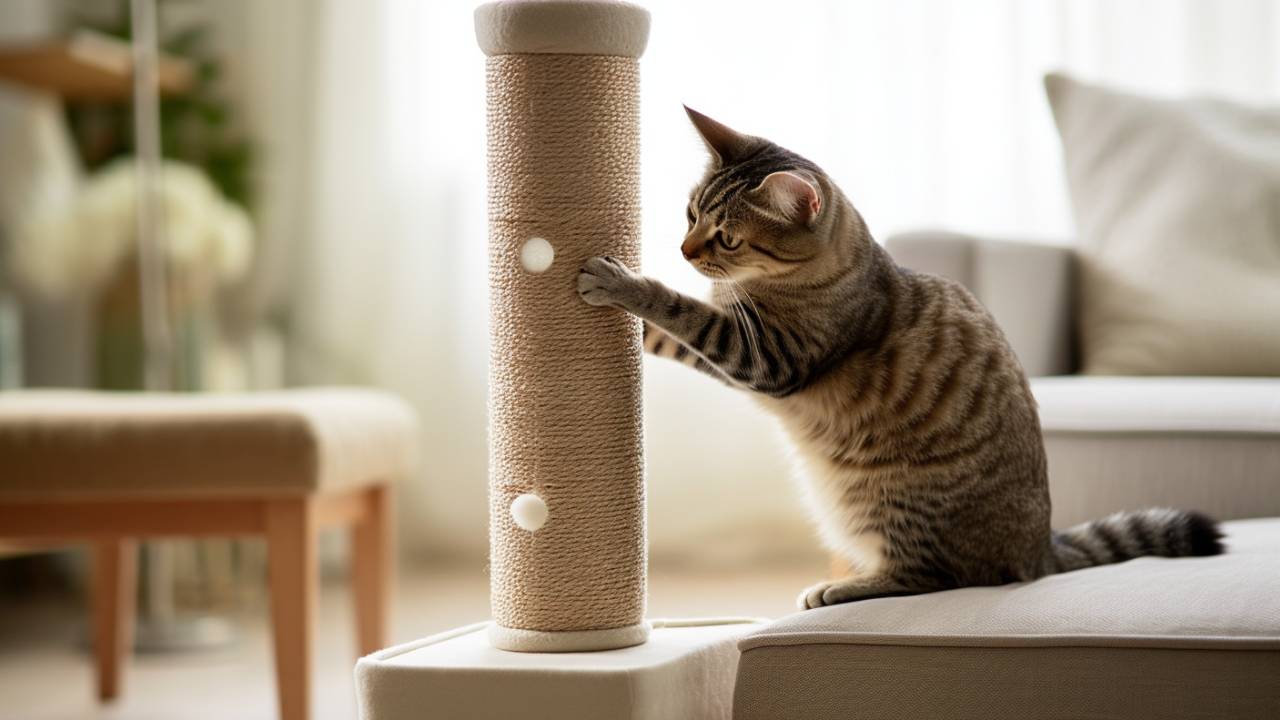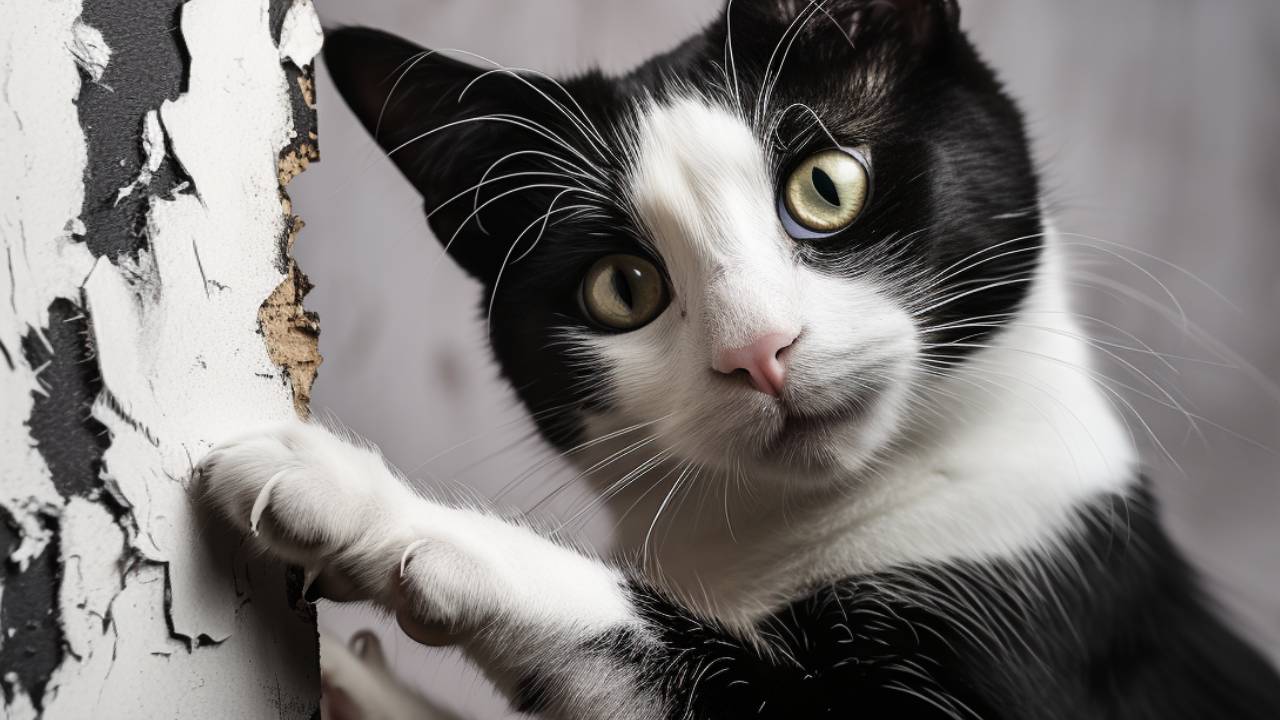If you’ve ever walked into a room only to find your feline friend enthusiastically scratching the wall, you’re not alone in wondering about this peculiar behavior.
In this article, we delve into the motives behind your cat’s wall-scratching tendencies, shedding light on their instincts and providing insights into how to redirect this behavior constructively.
Reasons Why Do Cats Scratch Walls and Corners
Cats are intriguing creatures with behaviors deeply rooted in their evolutionary history. Their tendency to scratch walls and corners can be attributed to instinctual, physical, and social factors. Here’s a closer look at why this behavior is so prevalent:
- To Mark His Territory: Scratching is a natural way for cats to mark their territory. When they scratch walls or corners, they leave behind both visible marks and pheromones from scent glands in their paws. This scent marking communicates vital information to other nearby cats, such as their presence, status, and even mood.
- Claw Maintenance: Cats’ claws are not just tools for climbing and self-defense; they also need regular maintenance. Scratching serves to remove the outer layers of their claws, revealing sharper ones underneath. Walls and corners offer an ideal texture for this natural manicure, helping cats keep their claws healthy and ready for various activities.
- Stretching and Exercise: The vertical surfaces of walls and corners provide an excellent opportunity for cats to stretch their bodies and flex their muscles. Cats are agile and flexible animals; a good stretch helps maintain their physical condition. Scratching against walls allows them to engage their core muscles, promoting overall well-being.
- Emotional Outlet: Cats may scratch walls and corners to release pent-up emotions or stress. This behavior can be particularly noticeable in multi-cat households or during times of change. Scratching can serve as a coping mechanism, allowing cats to alleviate their anxiety and feel more secure.
- Visual and Textural Appeal: Walls and corners might possess visual and textural characteristics that naturally attract cats. The contrast between the unusual surfaces and the cat’s claws provides sensory satisfaction. The challenge of reaching higher corners can be mentally stimulating, satisfying a cat’s innate curiosity and problem-solving tendencies.
- Social Influence: If you have multiple cats, one cat’s scratching can influence others to follow suit. Cats in a social group may scratch walls to reinforce a collective scent mark, contributing to a shared territory. This behavior helps establish a cohesive group dynamic among your feline companions.
By providing alternative outlets for cat scratching, you can create a harmonious home environment that accommodates your cat’s instincts while safeguarding your walls and furniture.

How Training Your Cats to Scratch the Right Places
Redirecting your cat’s scratching behavior from walls and corners to more appropriate surfaces is a gradual process that requires patience and strategic planning.
By understanding your cat’s preferences and employing positive reinforcement techniques, you can guide them toward the right scratching spots. Here’s a detailed approach to help you achieve this goal:
- Strategic Scratching Post Placement: Identify where your cat tends to scratch walls or corners the most. Place scratching posts near these locations to create a seamless transition. Choose posts of various textures and heights to cater to your cat’s preferences. The aim is to make scratching posts as appealing as their target walls.
- Enhance with Enticement: To attract your cat to the scratching posts, sprinkle them with catnip or use a pheromone spray. These enhancements tap into your cat’s sensory interests and encourage them to investigate the new scratching options. The scent of catnip or familiar pheromones can make the posts even more inviting.
- Positive Reinforcement: When your cat uses the scratching posts, reward them with praise, affection, and treats. Positive reinforcement helps establish a strong connection between the desired behavior and positive outcomes. Cats are likelier to repeat behaviors that lead to pleasurable experiences, so ensure the rewards are genuinely enjoyable.
- Discourage Unwanted Behavior: While you encourage appropriate scratching, discourage wall scratching by making those areas less appealing. You can use double-sided tape, aluminum foil, or plastic mats to cover the walls temporarily. These textures discourage scratching and help break the habit.
- Variety of Scratching Options: Various scratching unusual surfaces and textures besides traditional scratching posts are provided. Horizontal cardboard scratchers, sisal mats, and wooden logs can all be enticing options.
- Regular Maintenance: Keep the scratching posts clean and well-maintained. Trim any frayed edges or replace worn-out posts to ensure they remain attractive and safe for your cat. A well-maintained scratching post is more likely to hold your cat’s interest.
The goal is not to eliminate your cat’s scratching behavior but to guide it toward appropriate outlets. Investing time and effort into training will protect your walls and furniture and nurture a healthier relationship between you and your cat.
Conclusion
Understanding your cat’s need to scratch walls and corners is the first step in preventing your cat from scratching it; thus, training your cat to use scratching posts prevents wall damage and positively nurtures their natural behaviors.
You can guide them toward more suitable scratching habits by recognizing their instincts to mark territory and maintain healthy claws.

FAQs
Is it normal for cats to scratch walls?
Yes, scratching walls is an expected behavior among cats. It serves multiple purposes, including territory marking and claw maintenance.
How can I protect my walls from cat scratches?
Providing scratching posts, covering walls with cat-friendly materials, or using double-sided tape can deter cats from scratching walls.
What type of scratching post is best?
Cats have different preferences for textures and heights. Experiment with various scratching posts to find the one your cat prefers.
Can I train an older cat to use a scratching post?
Yes, older cats can learn new behaviors. Use positive reinforcement and patience to guide them toward using scratching posts.
Should I trim my cat’s claws if they scratch walls?
Regular claw trimming can reduce the need for scratching, but it should be done carefully. Consult a veterinarian or groomer for guidance.
Will spaying/neutering stop wall scratching?
Spaying/neutering can reduce territorial behaviors, but training is still necessary to redirect scratching to appropriate places.
Why does my cat scratch only specific walls?
Cats scratch areas they consider prominent for territory marking. Specific walls hold significance due to scent or location.






he doesn’t like the pattern😆😆😆
My cat’s wall scratching habit is driving me crazy! Your article shed light on possible reasons behind this behavior